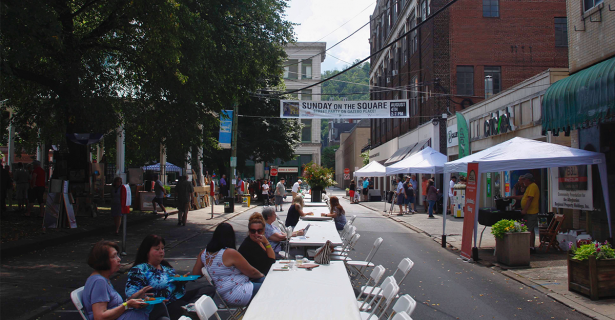Halfway through our month-long research in the post-industrial city of Johnstown, Pennsylvania, we found ourselves attending Sunday on the Square, a bustling festival hosted by local nonprofits showcasing local food and businesses. I, with my fellow peers Carlos Irisarri and Arjun Padalkar, decided to spend the month of August in Johnstown to better understand the strategies which cities employ to recover and revitalize themselves to staunch the outflow of people and to encourage more people to move to the area. Sunday on the Square was one such initiative.
Founded in 1800 by Swiss German immigrant Joseph Johns, Johnstown found its strength with the arrival of the steel industry in 1852 through the Cambria Iron Company. With a peak population of approximately 70,000 after the turn of the century, Johnstown’s mountainous landscape allowed for heightened economic growth as a result of their natural resources of iron and coal.
The fall of the steel industry, thought, spelled disaster for Johnstown. The de-industrialization of the U.S. started a vicious cycle in cities dependent on manufacturing, especially steel towns. The loss of industry created an economic vacuum that then amplified out-migration, which created more of an economic downturn. On top of all that, the deep valley that Johnstown resided in also contributed to its downfall as its frequent flooding accelerated the collapse of Johnstown’s necessary infrastructure. Over the past thirty years, people left Johnstown en masse. Now with the population at less than 20,000 and a per capita income of $23,636, the future did not seem bright for the poorest city in Pennsylvania.
Some cities crumble under this type of pressure. Johnstown is not one of those cities. Instead, Johnstown is a city that is fighting back and looking toward the future.
A few days before the festival, we had spoken to Melissa Komar at the Johnstown Redevelopment Authority to hear her thoughts on Johnstown’s modern problems. We quickly learned that the negative perception of the downtown district played a crucial role in Johnstown’s inability to keep its population. Johnstown’s blighted properties, as well as the perception of a lack of business downtown, were strong factors that lead to this negative image.
After our conversation, she directed us to Sunday on the Square. Spearheaded by local community leaders at Vision 2025, funded by the Community Foundation for the Alleghenies, and hosted by the Gallery on Gazebo – all organizations focused on the redevelopment of the Greater Johnstown Area – Sunday on the Square was a new event with the goal of community building and revitalizing the downtown. It would host local restaurants as well as showcase the work from local artists to improve public opinion of the downtown. We decided to talk to people on that Sunday to see if this festival was an effective way toward revitalization.
With local musicians playing old classics, we walked along the edge where people were eating and enjoying the afternoon. We met the owner of Rayne’s Barbeque, a restaurant that we would soon learn to enjoy as much as the locals. We spoke with Todd Stiffler, an artist whose murals lighten up downtown. Eventually, we moved into the park to conduct some informal interviews with locals to hear their thoughts.
When asked about Sunday on the Square, one Johnstown native in his early twenties had this to say, “I’ve lived here my whole life. It’s my home. And I have hope that it’ll really come together for the people who are sticking around.”
As he talked to us, he explained how difficult it was being raised in the years of the economic downturn. “We weren’t really able to move past the steel collapse fast enough, because that’s not where the money is anymore. But I feel like we’re really coming out of it. It just feels good to see everyone here having a great time.”
We spent a few more hours enjoying the festivities and talking to other people about their experiences. With his arms crossed around his chest, an older Johnstown native explained how his experience in the downtown district over the years matched the negative perception the Redevelopment Authority warned us about.
“I’ve been here for about fifteen to twenty years now. Johnstown’s cool, but it’s a recovery town. The last couple years have been bad. People are here for recovery, for drugs and stuff like that.” Even still, he assured us that his own perception of his town had been changing. “Events like this that they have are the best things they could have for the city.”
“There used to be something here once a month. But the feds and the police, they shut it down because of a lot of violence years ago. So, they stopped doing everything for a while. But now, this is the first time they’re doing this [specifically]. They’re trying to get more things involved for the community. They’re trying to get more stuff involved downtown. So hopefully they’ll keep it up.”
After speaking with him, we left downtown to prepare for the next day of interviews. It was clear to us that despite the long road ahead, Johnstown’s dedication to changing its perception was working and that events such as Sunday on the Square helped in the larger goal of revitalizing and rebuilding a city that years ago was left behind.

